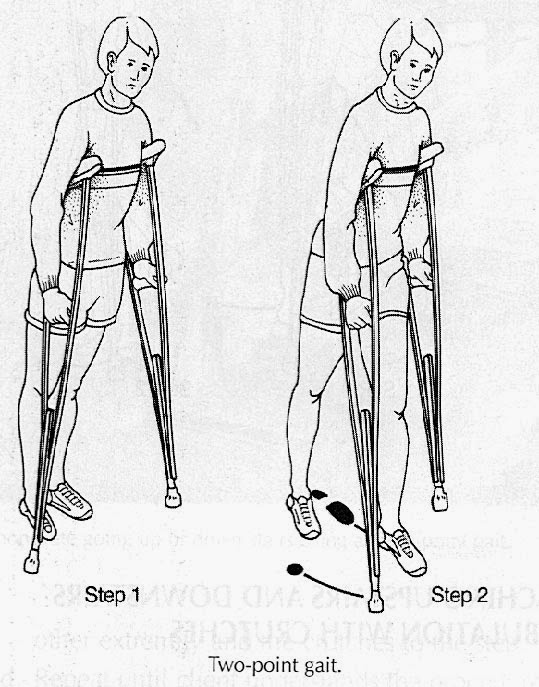The 2 point gait is a fundamental ambulation technique often utilized in physical therapy and rehabilitation settings. This method of walking is designed to offer stability and balance, particularly for individuals who may have suffered injuries or have mobility issues. By learning and mastering the 2 point gait, patients can regain their confidence and independence in moving from one place to another, which is crucial for their overall recovery and quality of life.
In the 2 point gait, the individual moves two points of support simultaneously, creating a rhythm that mimics natural walking patterns. This approach is particularly beneficial for those using assistive devices such as crutches or canes. It provides a sense of security while allowing for a more efficient and fluid motion. Understanding how to properly execute this gait can significantly impact a person's ability to navigate various environments safely.
In this article, we will delve deeper into the intricacies of the 2 point gait, exploring its mechanics, benefits, and the situations in which it is most effective. We will also answer common questions about this technique and offer guidance for those looking to incorporate it into their rehabilitation process.
What is the 2 Point Gait?
The 2 point gait is a walking pattern where two points of support are moved in coordination. This often involves the use of crutches or a cane, where the individual moves the device alongside the opposite leg simultaneously. This method is particularly advantageous for those who require additional support while walking.
How Does the 2 Point Gait Differ From Other Gait Patterns?
To fully appreciate the 2 point gait, it is important to understand how it stands apart from other gait patterns such as the 4 point gait or swing-to gait. The main difference lies in the number of points of support used and how they are coordinated during movement. Here are some distinctions:
- **4 Point Gait**: Involves moving each assistive device and leg independently, which can provide more stability but slower movement.
- **Swing-To Gait**: Involves swinging the legs to meet the assistive device, which can be less stable but allows for quicker movement.
Why is the 2 Point Gait Important?
The 2 point gait is crucial for individuals who have impaired mobility. It helps in:
- Enhancing balance and coordination
- Improving overall strength in the legs
- Providing a safer means of ambulation
- Encouraging independence in daily activities
Who Can Benefit from the 2 Point Gait?
The 2 point gait can be beneficial for a wide range of individuals, including:
- Those recovering from surgery or injury
- Individuals with neurological conditions affecting mobility
- Patients with balance issues or gait abnormalities
How to Properly Execute the 2 Point Gait?
To effectively practice the 2 point gait, follow these steps:
- Stand upright with your assistive device in one hand.
- Step forward with the device and the opposite leg simultaneously.
- Shift your weight onto the device as you bring your other leg forward.
- Repeat the process in a smooth, rhythmic motion.
What Are the Challenges of the 2 Point Gait?
While the 2 point gait is an effective technique, it may present certain challenges:
- Difficulty in maintaining balance initially
- Potential for fatigue during longer distances
- Need for continuous practice to master the rhythm
How Can One Improve their 2 Point Gait Technique?
Improving the 2 point gait technique involves practice and possibly guidance from a physical therapist. Here are some tips:
- Practice in a safe, open space to build confidence.
- Use mirrors or video recordings to self-assess form and technique.
- Engage in strength training exercises to enhance leg strength.
- Incorporate balance exercises into your routine.
Conclusion: Embracing the 2 Point Gait
The 2 point gait is an invaluable tool for many individuals seeking to regain mobility and independence. By understanding its mechanics and benefits, individuals can work towards improving their ambulation skills. Whether in a rehabilitation setting or at home, mastering the 2 point gait can lead to greater confidence and physical capability.
Biography: A Case Study in 2 Point Gait Rehabilitation
To illustrate the impact of the 2 point gait, let’s look at the case of John Doe, a 45-year-old male who underwent knee surgery. His rehabilitation journey involved mastering the 2 point gait to regain mobility.
| Personal Detail | Information |
|---|---|
| Name | John Doe |
| Age | 45 |
| Condition | Knee Surgery Recovery |
| Rehabilitation Duration | 3 Months |
| Goals | Regain full mobility and independence |
John's journey showcases the significance of the 2 point gait in his recovery process. Through dedication and practice, he was able to regain his mobility and return to his daily activities with confidence.



